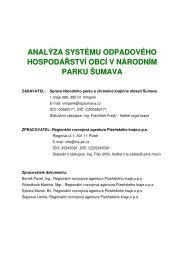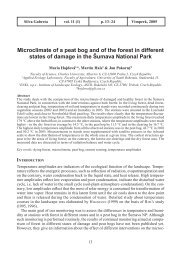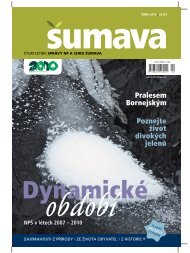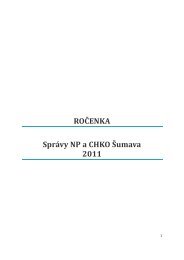(Pseudophilotes baton) (Lepidoptera: Lycaenidae) - Národní park ...
(Pseudophilotes baton) (Lepidoptera: Lycaenidae) - Národní park ...
(Pseudophilotes baton) (Lepidoptera: Lycaenidae) - Národní park ...
Create successful ePaper yourself
Turn your PDF publications into a flip-book with our unique Google optimized e-Paper software.
olokality, obsazené jen malými koloniemi, perspektivy motýla to těžko zlepší.<br />
Modrásek černočárný je jednoznačně vázán na ranná sukcesní stadia vegetace, udržované<br />
v dávné minulosti přirozenými disturbancemi (sesuvy, záplavy…), později tradičním hospodařením<br />
v krajině, především extenzívní pastvou. Intenzifikace hospodaření, spontánní zarůstání<br />
krajiny a zalesňování zmenšily a izolovaly jednotlivé kolonie. Modrásek leckde přežil<br />
jen díky aktivitám armády, pohraničníků a těžařů surovin, neboť tyto aktivity<br />
zajišťovaly přítomnost narušovaných plošek v krajině. Dnes jsou i poslední zbytky výskytu<br />
ohroženy sukcesí. Má-li u nás druh přežít, musíme pro jeho lokality zajistit aktivní management,<br />
jakož i zvětšení stávajících biotopů formou výřezů křovin, pastvy a mechanických<br />
disturbancí (ekologická obnova). Jako slibná se jeví spolupráce s armádou ČR (VVP Boletice)<br />
i vlastníky některých lokalit (Kašperské hory, Novohradské hory). Pro tento unikátní a<br />
kriticky ohrožený druh by měl být připraven záchranný program, spočívající na spolupráci<br />
všech zúčastněných stran.<br />
Acknowledgements. O. Kudrna communicated to us detailed circumstances of P. <strong>baton</strong> discovery, butterfly<br />
recorders O. Adam, J. Majer, P. Pech, R. Janák, and J. Skala shared with us their original P. <strong>baton</strong><br />
observations. J. Beneš, A. Bezděk, and P. Bogusch helped us with hardly accessible literature; J. Beneš was<br />
also indispensable for organising surveys of some localities. T. Kadlec acquainted us with populations of P.<br />
vicrama within the city of Prague. Czech Army and the owner of the Novohradské Hory Mts. site are to be<br />
thanked for entry permits and for active participation in preserving the butterfly. Surveys of P. <strong>baton</strong> were<br />
funded by Czech Conservation Authority, Grant Agency of AS CR (KJB600070601), Ministry of Environment<br />
(SP/2d3/153/08) and Ministry of Education (6007665801 and LC06073).<br />
REFERENCES<br />
BENEŠ J. & KONVIČKA M., 2008: Tucet odsouzených: Denní motýli, kterým Natura 2000 nepomůže [The twelve<br />
that are doomed: Vanishing butterflies not protected by Natura 2000]. Ochrana Přírody, in press (in Czech).<br />
BENEŠ J., KONVIČKA M., DVOŘÁK J., FRIC Z., HAVELDA Z., PAVLÍČKO A., VRABEC V. & WEIDENHOFFER Z., 2002: Butterflies<br />
of the Czech Republic: Distribution and conservation I., II. SOM, Praha, 857 pp.<br />
BEURET H., 1943: Philotes vicrama Moore, eine für die Schweiz neue Lycaenide (?). Mitteilungen Schweizerische<br />
Entomologische Geselschaft, 18: 523–525.<br />
BOGUSCH P., 2006: Výsledky faunistického průzkumu vybraných čeledí motýlů (<strong>Lepidoptera</strong>) na Blatensku [Results<br />
of faunistic surveys of selected lepidopteran families near Blatná]. Erica, 13: 67–84 (in Czech).<br />
EBENHÖH J., 1965: Příspěvek k poznání jihočeské fauny Rhopalocer [A contribution to understanding of South-<br />
Bohemian Rhopalocera]. Sborník Jihočeského muzea v Českých Budějovicích, Přírodní vědy, 5: 84–87 (in<br />
Czech).<br />
EBERT G. & RENWALD E., 1991: Die Schmetterlinge Baden-Württembergs, Bd. 2 Tagfalter II. Eugen Ulmer, Stuttgart,<br />
516 pp.<br />
FIEDLER K., 1991: European and North West African <strong>Lycaenidae</strong> (<strong>Lepidoptera</strong>) and their associations with ants.<br />
Journal of Research on the <strong>Lepidoptera</strong>, 28: 239–257.<br />
GRILL A., CRNJAR R., CASULA P. & MENKEN S., 2002: Applying the IUCN threat categories to island endemics:<br />
Sardinian butterflies (Italy). Journal of Nature Conservation, 10: 51–60.<br />
HANSKI I., 2005: The Shrinking World: Ecological Consequences of Habitat Loss. Ecology Institute, Oldendorf/<br />
Luhe, 307 pp.<br />
HOYLE M. & JAMES M., 2006: Global warming, human population pressure, and viability of the world’s smallest<br />
butterfly. Conservation Biology, 19: 1113–1124.<br />
KADLEC T., BENEŠ J., JAROŠÍK V. & KONVIČKA M., 2008: Revisiting urban refuges: Changes of butterfly and burnet<br />
fauna in Prague reserves over three decades. Landscape and Urban Planning, 85: 1–11.<br />
KONVIČKA M., BENEŠ J.. & ČÍŽEK L. 2005. Ohrožený hmyz nelesních stanovišť: ochrana a management [Endangered<br />
insects of non-wooded habitats: Conservation and management]. Sagittaria, Olomouc, 79 pp. (in<br />
Czech).<br />
KONVIČKA M., FRIC Z. & BENEŠ J., 2006: Butterfly extinctions in European states: do socioeconomic conditions<br />
matter more than physical geography? Global Ecology and Biogeography, 15: 82–92.<br />
KUDRNA O., 1994: Kommentierter Verbreitungsatlas der Tagfalter Tschechiens. Oedippus, 8: 1–137.<br />
KUDRNA O., 2002: The distribution atlas of European butterflies. Oedippus, 20: 1–342.<br />
LEIGHEB G. & CAMERON-CURRY V., 1998: Observations on the biology and distribution of <strong>Pseudophilotes</strong> barbagiae<br />
196


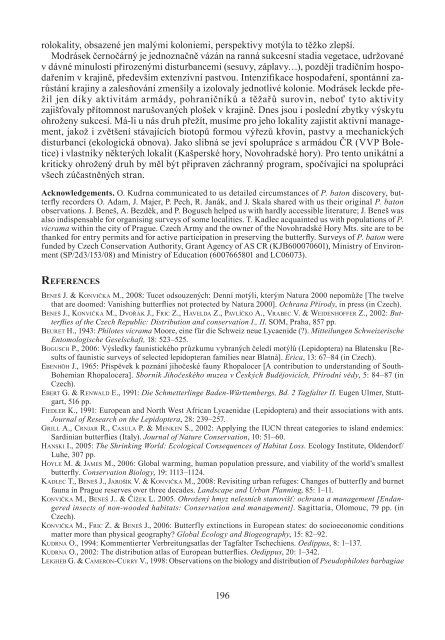
![Zima 2008 [4MB] - Národní park Šumava](https://img.yumpu.com/21236024/1/184x260/zima-2008-4mb-narodni-park-sumava.jpg?quality=85)
